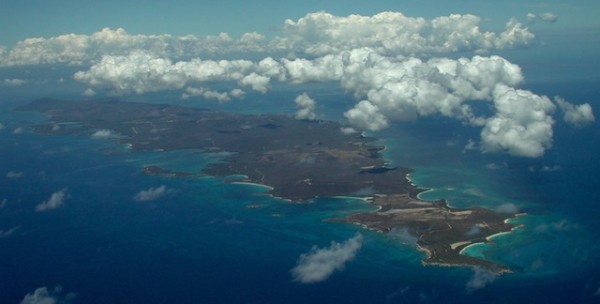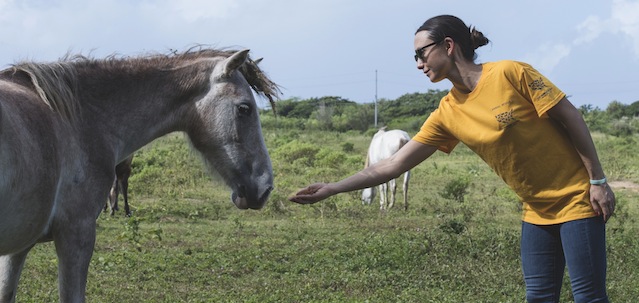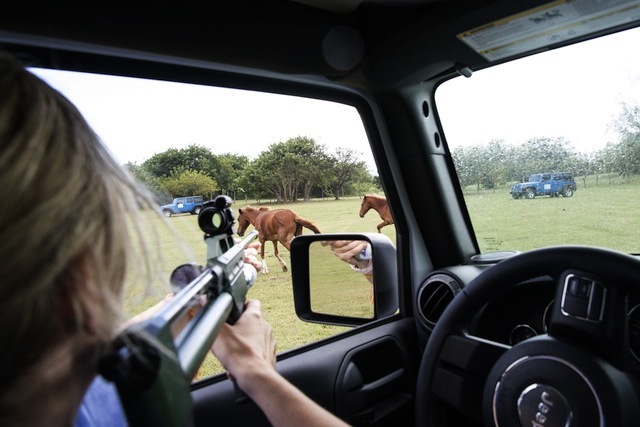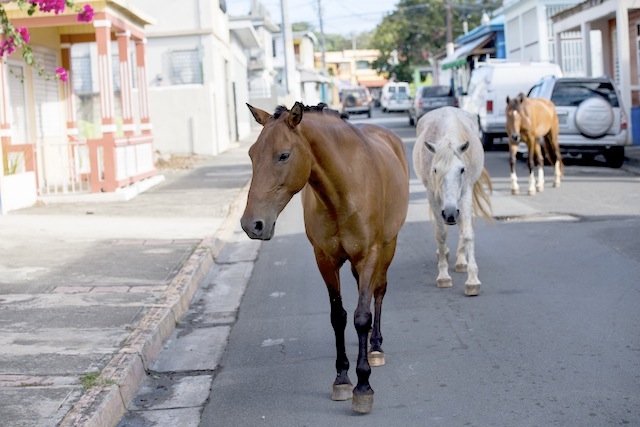Free Range in Paradise: The “Wild” Horses of the Caribbean Attract Tourists and Research
- March 10, 2017
- ⎯ Fran Jurga

Wild horses are supposed to be in the wild west, scampering up and down mountainsides or galloping across the desert, right? That’s what most of us have always thought. But as support for the preservation of feral horses in the western rangeland of the United States has grown, so has the awareness and appreciation of large and small herds of feral horses around the world.
Feral horses are those who live in the wild but are descended from domestic horses. The only true “wild” horses live in Mongolia.
When The Humane Society of the United States announced it was heading to a place called “Vieques” (pronounced “vee-AAAY-kez”) to help wild horses there, many followers just scratched their heads.
Feral horses show up in unusual places. They live on the remote Canadian sandbar known as Sable Island, off Nova Scotia. They live in the Balkan nations of eastern Europe, the south of France, and the mountains of Spain. You’ll find the largest concentration of free-roaming horses thriving in the extreme wilderness of Australia’s Outback. Horse herds live in the brutal desert of Namibia in Africa.

Feral and wild horses are a key part of the ecotourism industry. People are willing to travel to places where they can see horses in their wild, natural state, as evidenced by feral horse advocate Madeleine Pickens’ landmark Mustang Monument ecotourism resort in Nevada.
One of the most unusual herds lives on the U.S. territory of Vieques, an island off Puerto Rico in the Caribbean Sea. Much of Vieques was once a bombing practice range for the U.S. Navy, but when the bombs stopped falling, and the military base was converted to a wildlife refuge, tourists from around the world took it as an “all clear” to visit.
Some came for the beaches. Some came for the quiet. And some came to see the “wild” horses. Over decades, hundreds of domestic horses, many of Paso Fino blood, had been turned loose to roam by their owners. They gradually spread out over the island, reproduced, and learned to live among the citizenry. Now they are not only part of landscape, they are also part of the island’s allure.
Here’s a short tourist video from YouTube.com showing a herd near Sun Beach on the island:
Over the years, the island has become more settled and widely-known not for its highrise hotel resorts but for the peace and quiet and, yes, the horses. They have helped put the island on the map, as a wildlife feature that sets the island apart. Their presence makes a hike to the beach an adventure, when you realize that you might frolic in the surf next to a mare and her foal.
These horses may not be very wild, given the way they have been fed by locals and tourists alike for generations. “Free ranging” might be a better description. Tourists enjoy “capturing” them on film, cell phone cameras, and video, and the herds don’t seem to mind being a little bit famous. Many are approachable, up to a point, and some are claimed as the unfenced property of local residents, as evidenced by their brands.
Lately, it’s not only tourists who are seeking the horses on Vieques. Researchers, animal advocates, photographers, filmmakers, and even a veterinarian are looking for hoofprints in the sand, as well.
The off-islanders’ interest in this fascinating home turf for free ranging equids extended to an equine contraceptive mission led by the Humane Society of the United States (HSUS) on the island last week.

Back in 2015, HSUS announced a strategic partnership with the island’s government to improve all animal welfare on the island. The programs have ranged from educating law officials about animal abuse to schoolroom programs and vaccination/spay/neuter clinics for small animals.
But you can’t go to Vieques and not be aware of the horses. Who was looking out for their welfare? And who was working to insure their future? While the island has plenty of wild terrain, its natural vegetation can only sustain so many horses. And the herds were growing larger each year.
Last year, the mayor of the island, Victor Emiric, asked HSUS what could be done to improve welfare and simultaneously control the growth of the horse herds on the island. Whether tourists are motivated to visit the island because of the horses or not, the public image of the island will not be enhanced if the ubiquitous horses don’t look like they are healthy and happy.

First things came first, in the HSUS program. Fresh water access is a problem for the horses; many of the herds moving around the island are motivated to meander by their search for fresh water sources. HSUS has begun to install water troughs closer to unpopulated areas, to lure horses away from congested town areas with a guarantee of clean, unsalty water.
Key to the HSUS involvement is a program to administer the contraceptive known as Porcine zona pellucida (PZP), which has been used on many different types of wildlife, including wild horse mares in the American West. HSUS planned to inoculate more than 150 mares during this initial program.

According to a comment by HSUS President Wayne Pacelle in his blog recently, PZP “has been studied extensively for more than 20 years, and it has been proven to be more than 90 percent effective and safe.” HSUS, in fact, was involved with its development.
“Treated mares will see increased health benefits and will lead longer and healthier lives without the stress of repeated pregnancy and lactation in an environment with few basic resources,” Pacelle wrote. “In the long term, the competition for scarce resources will decrease as the population stabilizes and declines to sustainable levels.”
PZP has been used on Assateague pony mares on federal land in Maryland since 1988. According to HSUS, last month the National Park Service declared the wild horse fertility control program on Assateague such a success that the herd will be allowed to reproduce again for the first time in six years.
According to Liz Davis, education coordinator for Assateague Island, “The Maryland herd of wild horses currently contains a large proportion of mares aged 20 to 33,” she told the website DelmarvaNow.com. “These older mares are unlikely to foal again, so in order to refresh the reproductive population in the near future, an increase in foaling among the younger mares needs to occur.”
When tourists come to see the horses, they love to see foals romping around. The decrease in foals caused by the PZP program will need to be explained to the tourists.
The medication is not without its critics. Friends of Animals is one organization opposed to the use of PZP.

The HSUS program last week, which centered on “darting” mares with the contraceptive vaccine, included a visit to the island by an equine practitioner. Dickie Vest, DVM, staff veterinarian for the Cleveland Amory Black Beauty Ranch in Texas, had the honor of being the island’s first-ever horse doc during his stay.
According to HSUS, Vieques will serve as a positive model for large-scale horse population management. They suggest that their Vieques program can be replicated by other municipalities, as well as state, federal and tribal agencies that are actively searching for ways to manage feral horse populations.
Special guests enjoying the wild horses last weekend were celebrity supporters of HSUS (and equestrians), such as Georgina Bloomberg, Stephanie Riggio Bulger and Ariana Rockefeller. Tourists and HSUS staff and guests alike had an unusual opportunity to see the horses up close during the clinic.
Most of the horses didn’t mind posing for photos with the celebrities and staff. Then they just wandered off, as if nothing was going on. It was just another day in paradise, for them.
by Fran Jurga
Learn more:
Europe Plans for Eco-Friendly (Re)wild Horses on the Edge of the Landscape
Where the Wild Horses Are (Australian Geographic Society): Australia is home to a million wild horses.
Whither the wild horses of Louisiana?
Is PZP Safe? Immunocontraceptive Vaccines and Their Regulation (HSUS document)
Critique of PZP from Friends of Animals website






